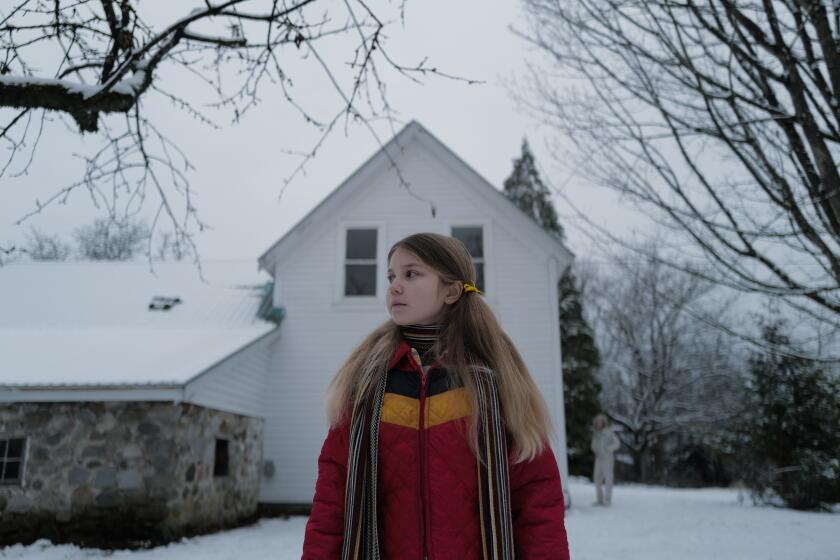ON LOCATION : MOVIES : Schrader’s Trilogy : The creator of ‘Taxi Driver’ and ‘American Gigolo’ delves further into the lives of social reprobates with ‘Light Sleeper’
Anyone familiar with Paul Schrader’s work will not be surprised to learn that the title of his new film, “Light Sleeper,” is taken from the Bible. A successful screenwriter (“Taxi Driver,” “Raging Bull,” “The Last Temptation of Christ”) and occasionally successful director (“American Gigolo,” “Mishima” and “The Comfort of Strangers”), Schrader is known for spinning dark morality tales whose most common theme is redemption. His best-known protagonists--Travis Bickle, Jake La Motta, Julian Kay, Jesus Christ--have been lonely outsiders struggling to fulfill a calling. As Schrader once described “Taxi Driver,” “it is waist-deep in Calvinistic notions of worthlessness, purging, blood redemption.”
Now in “Light Sleeper,” the story of an aging drug dealer that Schrader wrote and is directing in New York this summer for release next spring, he explores similar Christian-based themes.
“The title is from the New Testament--St. Paul,” says Schrader during a recent afternoon on the set, a loft in Manhattan’s SoHo district. “It won’t be in the movie, but it’s from that verse in Corinthians, “Behold I show you a mystery; we shall not all sleep, but we shall all be changed.”
As in his other films, the focus of that change is a quasi-apocalyptic catharsis experienced by the protagonists--here, two middle-age, middle-class drug dealers, played by Willem Dafoe and Susan Sarandon. After several years serving their tony clientele from a chic Upper West Side apartment--”a salon-type atmosphere turned into a fast-food delivery service,” as Sarandon describes it--the two dealers are forced to re-evaluate their careers and relationship in a post-crack, post-AIDS generation.
On one level, the film is something of a departure for Schrader, who is known for his spare, existential scripts. “Taxi Driver,” for instance, which indirectly became part of the controversy surrounding John Hinckley’s 1981 assassination attempt of President Reagan, drew as much upon Sartre and Dostoevsky as it did upon psycho-drama traditions. “Light Sleeper,” conversely, has a romantic-thriller structure and unusually witty tone--sort of “thirtysomething” meets “New Jack City.”
Thematically, however, the film is solidly within the director’s canon. “Light Sleeper” represents a return by the director to familiar subject matter after disappointing critical and box-office responses to his more recent films. These include “Light of Day,” his 1987 examination of the rock-and-roll world that starred Joan Jett and Michael J. Fox; “Patty Hearst,” his 1988 docudrama about the kidnaping of the California heiress, and “The Comfort of Strangers,” a film adaptation of Ian McEwan’s novel of sexual gamesmanship that featured Christopher Walken and was released earlier this year. Indeed, Schrader intends “Light Sleeper”--his first auteur project since “Mishima,” his 1985 stylized, deconstructed homage to Yukio Mishima, Japan’s finest postwar author, who died in a suicide in 1970--to conclude the trilogy he began with “Taxi Driver,” directed by Martin Scorsese in 1976, and “American Gigolo,” which Schrader wrote and directed in 1980. Schrader considers this protagonist, John LaTour, the 40-year-old drug delivery boy (Dafoe), as an older but not necessarily wiser version of Travis the cabbie and Julian the prostitute.
“This is not the first time that I’ve written this character,” says Schrader, leaning against the wall of the set, LaTour’s seedy but artistic New York apartment. “When he was in his 20s, he was angry and paranoid--a lonely cabdriver. When he was in his 30s, he was narcissistic and self-involved--a gigolo. Now he is in his 40s and he is an anachronism--like the drug culture is an anachronism. He is a listener, he takes confessions. That scarf he always wears, it’s his vestment.” Schrader suggests that while the times have changed, his protagonist remains “a wanderer, a voyeur, not really a person but a soul in search of a body to inhabit.”
Although Schrader has acknowledged that much of “Taxi Driver” was based upon his own troubled personal life at the time, he says the the idea for this film came to him in a dream “about a drug dealer I used to know during the heyday of Los Angeles’ cocaine culture in the 1970s and early ‘80s.”
In his usual rapid-fire work pace, Schrader wrote the first draft of “Light Sleeper” in less than four weeks last winter. He initially asked Robert De Niro to play the lead as a reprise of his role in “Taxi Driver,” but De Niro’s availability was two years off, Schrader says. He then cast Dafoe, the 36-year-old angular-faced actor who had worked with Schrader two years earlier when Scorsese had cast him as the lead in “The Last Temptation of Christ.” “I had a couple of nearly impossible speeches in ‘Temptation’ and they worked because of Willem,” Schrader says. “He is an actor who can do difficult things with nuance.”
Dafoe, who is also a member of the Wooster Group, a New York-based avant-garde theater troupe, says he chose to make “Light Sleeper” for about a quarter of his usual fee “because it was just the best script I had read in a long time.” He describes LaTour as “a guy who is very passionate but who has drifted, sort of an arrested adolescent. I see this in a lot of guys. He makes no moral judgments about what he does but he is struggling toward some sort of goodness or redemption.”
Sarandon, whose role in “Light Sleeper” is her first since “Thelma & Louise,” also signed on for less than her usual salary. Although she had never worked with Schrader, the actress has known the director for several years and was attracted to the role of the pragmatic, sardonic drug lord “who wants to get into herbal cosmetics” because “these people find salvation with each other. They’re a functioning family of dysfunctional people,” explained Sarandon in a phone interview. “It’s all about accepting a state of grace; Paul is very big on grace. It was also a non-waitress part that didn’t require an accent and Paul kindly condensed my time to about three weeks.”
David Clennon, who portrayed icy ad man Miles Drentell in TV’s “thirtysomething,” plays a member of that dysfunctional family. He is one of the few cast members who considers the film less interesting for its quasi-religious overtones than its accurate portrait of the drug industry. “Paul was raised a strict Calvinist and still has vestiges of his Christian faith,” says Clennon during an interview from his home in Los Angeles. “I don’t buy into that myself. The reason I like this script is because I’m a recovered addict. I know what it’s like to be on drugs and this film has a ring of verisimilitude while not supporting all the hysteria surrounding the current war-on-drugs campaign.”
Schrader, however, discusses the film largely in relation to the rest of the trilogy. Like “Taxi Driver” and “American Gigolo,” “Light Sleeper” owes much of its pacing and singular point of view to the works of French filmmaker Robert Bresson, a rigid formalist and one of Schrader’s longtime idols. (A key scene between Dafoe and Sarandon shot in a prison can be considered an homage to the conclusion of Bresson’s 1959 film “The Pickpocket.”) “I like to take those people society disapproves of and make them into--not heroes exactly--but protagonists,” Schrader says. “And I like that structure of seeing the world through the social reprobate’s eyes--this guy we are all supposed to disapprove of--so there is no other reality but his.”
Like the psychotic Travis and the emotionally cold Julian, LaTour is a deceptively impassive protagonist, a loner who spends most of his time cloistered in his room when he is not, quite literally, riding in a car in the service of other people. To achieve that claustrophobic perspective, Schrader filmed “Light Sleeper” in a series of apartment interiors and exterior urban car rides using a single camera in long dolly takes.
The director will score the film with a sequence of Bob Dylan songs recorded by Michael Been, a member of the Call. (Although Schrader had shot a video for Dylan in 1985, the singer refused to allow his voice to be used in this film.) “It will look nice and moody with a sheen to it,” says Schrader, who compares the film’s final look to “The Comfort of Strangers.” “I tend to put a sheen on things. I tend to work that side of the street.”
On this afternoon in the final weeks of the arduous two-month shoot, Schrader is directing one of the film’s final moments--LaTour’s reaction to the death of his girlfriend, Marianne, played by actress Dana Delany of “China Beach.” In the spacious SoHo loft, redesigned to represent LaTour’s cramped lower Westside apartment, Dafoe is hunched, ashen-faced, on the linoleum while listening to the voice of a radio newscaster announcing the death of a woman--Marianne--who has fallen 34 stories.
Like much of the 10-week shoot, the day is stifling hot--95 degrees in the non-air-conditioned loft. On several previous days, the temperatures were so extreme that the film melted, requiring the use of special air-conditioners mounted on the cameras. This afternoon, nearly everyone is making do in shorts and sneakers, and with Popsicles and cans of seltzer water. Between takes, the makeup artist repeatedly dabs at Dafoe’s damp face. “Just more ‘man in his room,’ ” says Schrader chuckling at the bleak scene in his video monitor. “A love story for our times.”
Adverse weather conditions aside, Schrader has battled even more severe financial constraints in bringing “Light Sleeper” to the screen. Although Lucasfilm had produced “Mishima” six years earlier--the film won three awards at Cannes that year--Schrader found few takers for “Light Sleeper.” “We were rejected by 29 studios,” he says with a rueful laugh.
Eventually, tired of waiting for piecemeal foreign financing, Schrader put up the initial $350,000 himself--”my entire savings” he says--and went into pre-production last spring. By then his agent, Jeff Berg at ICM had convinced Mario Kassar--head of Carolco, where Schrader currently has a contract to write an action picture for director Renny Harlin--to agree to a $6-million negative pick-up production deal. “I learned that from (Francis) Coppola,” says Schrader, “that if you pretend you are making a film long enough, eventually you will make that film.”
Shooting on the cheap has meant that, except for Sarandon and Dafoe, all the cast and crew are working for scale. “I think it actually cost me money to make the film,” says the Los Angeles-based Delany. “But Paul is one of the few directors who has a vision and it has been such a pleasure not to have to deal with a studio wanting to see dailies. It felt like a real family project.”
Schrader himself is drawing no salary, using his fee from “Comfort of Strangers” and the upcoming Harlin project to bankroll his time on “Light Sleeper.” “If you’re going to make sacrifices you have to do it from the top,” he says. “One of the reasons I can afford this is because of my other money gigs.”
And on one level, “Light Sleeper” can be seen as less an indicator of Schrader’s artistry than a barometer of his current standing within an industry that seems to prefer his talents as a screenwriter to his abilities as a director.
“I don’t believe that,” says Schrader flatly. “ ‘Taxi Driver’ has become a classic but in a way a classic is a curse. Marty (Scorsese) and I say that no matter what else we do, the obituaries will say ‘writer and director of “Taxi Driver.” ’ “
Schrader maintains that whatever their box-office vicissitudes, the films he has directed are among the work he’s most proud of. “ ‘The Comfort of Strangers,’ ‘Cat People,’ ‘American Gigolo’--I think were all good,” he says. “ ‘Light of Day’ I’m not happy with, but (‘Light Sleeper’) is well-directed, and ‘Mishima’ is outrageous in that it attempts to do something that is impossible--interweaving three different styles, three different concepts of reality. So no, I don’t terribly appreciate that attitude toward my work.”
Throughout the long afternoon, the bespectacled 45-year-old director, whose pudgy build and wry demeanor belie the dark films for which he is known--the Washington Post described “Comfort of Strangers” as “an elegantly wrought bit of nastiness”--paces his set like a cop on his beat. Between takes, Schrader alternates bottles of water with cigarettes with a continuing discussion of Hollywood and his position within it.
“Look, what does Hollywood think is topical?” he asks, lighting the first of several cigarettes. “ ‘Ghost’ and ‘Regarding Henry.’ But who are the good guys of ‘Taxi Driver’ and ‘Gigolo,’ two movies from which I still see money every year? I started out in a period when you could pitch any idea--’American Graffiti’ to ‘Taxi Driver.’ It’s different now. It’s different because studios make decisions based on their marketing departments. So people think only big-budget films are important. I mean I could put out a lot of disinformation on this film--like it cost $20 million--and I would get a lot more attention than I am now.”
Ask Schrader, who has been criticized for writing scripts with visual ideas that outpace their narrative content, why he thinks his interests have fallen from favor and he shrugs. “I think a script should seduce you verbally as well as visually . . . (but) the clearest answer I can get from any studio is ‘We don’t make movies like this.’ I’m considered ‘dark’ and if you want to dismiss anyone in this business call them ‘dark.’ The favorite thing I heard about myself was at Touchstone--’We like Schrader but he has trouble sharing his vision.’ ” Schrader laughs and blows smoke at the ceiling. “ ‘Sharing his vision,’ I like that.”
His particular vision, as is well documented, has been attributed to Schrader’s strict upbringing as the youngest son in a Dutch Calvinist household of celery farmers in Grand Rapids, Mich. He did not see his first movie until well in his teens and “I even went to seminary,” says Schrader, who adds, “I try to downplay that now. People like to put you in a box and when I first came along with ‘Taxi’ people said, ‘Violence, violence, violence, he only does violence,’ and they tended to harp on my religious background. What that means is that I’m not considered commercial, so they don’t have to take me seriously.”
Schrader, who attended Michigan’s Calvin College, became interested in film largely because it was forbidden by his church’s conservative teachings. He took some film history classes at Columbia and after graduation he became a protege of critic Pauline Kael, who helped Schrader win admittance to UCLA’s film school. He graduated a year early in 1971, writing his thesis on “Transcendental Style in Film.”
He worked briefly at the American Film Institute and later wrote reviews for the liberal paper, the L.A. Free Press and served as editor of the magazine Cinema. Eventually, Schrader says, “nonfiction didn’t cut it anymore.”
Schrader wrote his first important script, “Taxi Driver,” in 10 days during a period of personal unhappiness--”It sprang out of my head like an animal,” he has said of that initial screenplay. After that film was made in 1975, Schrader went on to write two more films for Scorsese--”’Raging Bull” in 1980 and “The Last Temptation of Christ” in 1988--as well “The Mosquito Coast” for Peter Weir and “Obsession” for Brian DePalma. His directorial debut came in 1977 with “Blue Collar,” which starred Harvey Keitel and Richard Pryor as Detroit auto workers. Since then, Schrader has written and or directed a fairly steady stream of films including “Hardcore” and the supernatural “Cat People.”
By the early 1980s, Schrader had left Los Angeles for New York, where he currently resides with his second wife, actress Mary Beth Hurt (who has a small role in “Light Sleeper”) and their two young children. “L.A. is a company town, particularly if you’re in the company I keep,” says Schrader about that move. “I was restless, a relationship had broken up, a drug problem was out of control and it was time to move. I came here and started over.”
Schrader also recently started over with his old agency, ICM, abandoning Creative Artists Agency after a single year. “What happened when I was at CAA? Nothing happened,” he says. “I’m a free-lance person and CAA is a corporate mentality. I say ‘let’s scheme’ and they want to package. I went back to ICM because they are very attuned to allowing me to have the career that I have. They are interested in all those little pockets of money around the world. They found me ‘Comfort of Strangers,’ which was Italian money. That wasn’t a gig CAA was going to get me.”
Schrader lights another cigarette and looks around the room at his sweat-drenched crew. “I’m a schoolyard scrapper,” he says sounding pleased and more than a little resolute. “I’m a conniver and a schemer who’s trying to pick up a few broken discarded objects and make some art.”
More to Read
Only good movies
Get the Indie Focus newsletter, Mark Olsen's weekly guide to the world of cinema.
You may occasionally receive promotional content from the Los Angeles Times.






